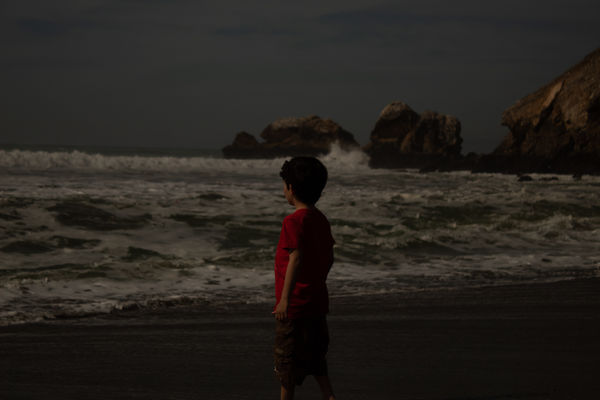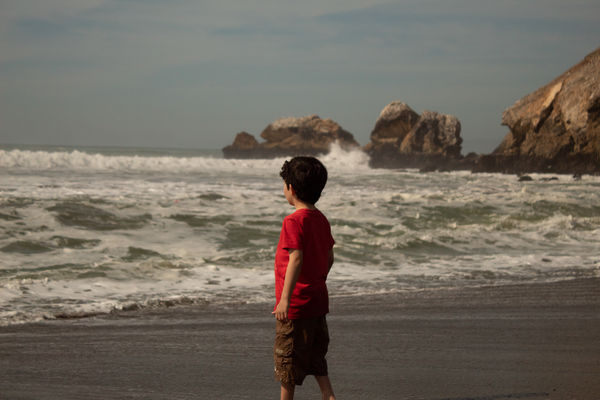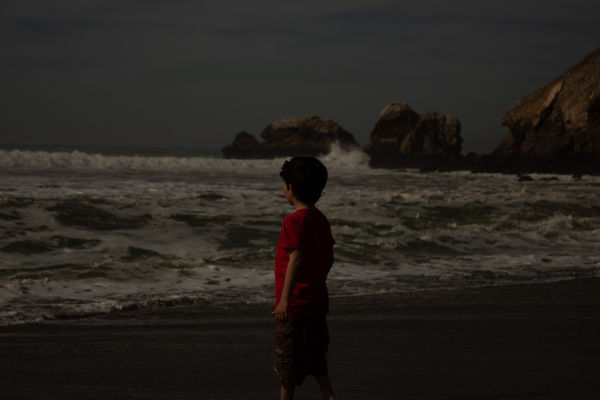Newb here: Exposure question with pictures included
Mar 19, 2019 14:23:35 #
Hello there UHH fam,
First of all I would like to say thank you for taking all my newb questions, it really helps! I took a bunch of beach pictures this weekend and used a circular polarizing filter by promaster. When I got home I noticed a lot of the pictures are underdeveloped. I shot them in Raw and uploaded the files to Lightroom and started playing around with adjustments. I noticed that once I increase the exposure and begin enhancing colors the image appears less crisp. So I have a few questions here but first some technical info: I shot with the canon rebel t6, kit 18-55 mm lens, Aperture priority set to 4.5 with focal length... maybe 45mm for this shot, I can't really remember unfortunately. and as mentioned, a promaster circular polarizing digital hd filter.
First question: Does the polarizer affect how the camera adjusts exposure parameters while in semi-auto mode i.e. aperture priority...
Second question: I noticed the filter twist turns which causes more or less polarization (seemingly to me) but there are no markings on the edge to tell you precisely what it is set for. Seems very non scientific and more like a guessing game when trying to get a good exposure. Not sure what my question is here so any and all advice and knowledge on polarizing filters would be very much appreciated!
Third question: Is it true that I am losing clarity when increasing exposure of my raw file in Lightroom or is it just something that I am perceiving because I don't have any experience to go off of.
Once again, thanks for all your help!
-Megan
First of all I would like to say thank you for taking all my newb questions, it really helps! I took a bunch of beach pictures this weekend and used a circular polarizing filter by promaster. When I got home I noticed a lot of the pictures are underdeveloped. I shot them in Raw and uploaded the files to Lightroom and started playing around with adjustments. I noticed that once I increase the exposure and begin enhancing colors the image appears less crisp. So I have a few questions here but first some technical info: I shot with the canon rebel t6, kit 18-55 mm lens, Aperture priority set to 4.5 with focal length... maybe 45mm for this shot, I can't really remember unfortunately. and as mentioned, a promaster circular polarizing digital hd filter.
First question: Does the polarizer affect how the camera adjusts exposure parameters while in semi-auto mode i.e. aperture priority...
Second question: I noticed the filter twist turns which causes more or less polarization (seemingly to me) but there are no markings on the edge to tell you precisely what it is set for. Seems very non scientific and more like a guessing game when trying to get a good exposure. Not sure what my question is here so any and all advice and knowledge on polarizing filters would be very much appreciated!
Third question: Is it true that I am losing clarity when increasing exposure of my raw file in Lightroom or is it just something that I am perceiving because I don't have any experience to go off of.
Once again, thanks for all your help!
-Megan

After increasing exposure, no other adjustments made.

Mar 19, 2019 14:32:16 #
Polarization will remove the glare try looking through a glass window with a reflection and rotate the filter until it goes away, or look down at a pond with fish in it and rotate the filter until the glare goes away
Mar 19, 2019 14:37:48 #
Old Timer
Loc: Greenfield, In.
It looks as if you were under exposed. In Raw you can increase exposure as you did but you will probably be under exposed in the shadows. Your polarizing filter depending the type that you have can be turned as you described to make the sky darker and or more blue to keep it from being blown out. If you hold your filter up to the light and rotate it you can see the difference as you turn it. You need to google or go to youtube and read up on filters. You will loose one to two stops when using it so remember that when using and over expose accordingly.
Mar 19, 2019 14:38:25 #
MissMegan wrote:
Hello there UHH fam, br br First of all I would l... (show quote)
First thing Megan, is to always tick the box that says (store original) when you upload a pic. This will allow us to see the image better and we can also see the metadata which will tell us what your exposure settings are.
#1 Question - yes, you loose about 1 stop of light with a polarizer but the camera should have compensated for it in Av mode. I don't know why it didn't so this is where seeing the EXIF or metadata could help. One thing you should do as a beginner is check your image on the LCD after you take a pic. You should see right away that it is or isn't exposed correctly. You can also use the histogram on your camera LCD. When viewing your image on the LCD press the Info button several times and the amount of info displayed on your LCD will change. You can choose only the image, or the image with a lot of other useful info to be displayed.
#2 Q - Yes, it's a matter of turning the ring and setting it for a pleasing amount of polarization. You might notice that on most polarizers the mfgrs name might be at the top or bottom of your lens when it's at full polarization.
#3 Q - Sometimes. If it's just a slight adjustment for exposure of say less than one stop then you shouldn't see any degrading of the image. If you have to use more than 1 stop you will see some degrading or noise in the image. That is why it's always best to try and get the exposure correct straight out of the camera. I have a bird pic that I was 3 stops under exposed and because the image was shot in raw, it came out quite acceptable. If you shoot in jpg, the image will fall apart fast if your exposure is off by more than a stop.
Now that I think about it a little more, I think you should check to see if your "exposure compensation" is set to a minus number. This is the only thing I can think of that would get it this underexposed.
One other thing about Polarizer filters, they really only work well under certain lighting conditions. The conditions you were in, not so good. They work best when the sun is about 90 off to one side or the other to your subject. They don't work well if the light is coming from behind or in front of the subject.
Mar 19, 2019 14:42:54 #
Polarizers only work on a 90 Deg angle to the Sun, so there compositions where it will, or won't be useful. And, it really makes a difference in the quality of a polarizer; I've ruined great lenses with crappy CPLs.
Do you have the latest Adobe Creative Cloud version of Lightroom Classic CC? If so, use the Auto button in the Develop module Basic panel to see what Adobe's AI thinks is the best exposure. A great place to start before other changes.
Your second image is muddy, and with the latest Lightroom, you should have been able to recover the image more than what you posted.
Do you have the latest Adobe Creative Cloud version of Lightroom Classic CC? If so, use the Auto button in the Develop module Basic panel to see what Adobe's AI thinks is the best exposure. A great place to start before other changes.
Your second image is muddy, and with the latest Lightroom, you should have been able to recover the image more than what you posted.
Mar 19, 2019 14:45:36 #
Use your histogram and high-light warnings to evaluate the resulting exposure of one or more test exposures. The histogram, after capturing the first image example above, would show the data was stacked to the left. In Aperture Priority, use Exposure Compensation to 'push' the exposure to the right, creating a better overall exposure. See your User Manual for the location of the EC control on you model. In your RAW capture to maximize the data captured for editing, you'd expect to see the white of the wave on the horizon to be slightly blinking in the highlight warnings for a "good" exposure to begin your RAW edits.
Although you failed to store the attachment for detailed analysis, one can see the color cast in your edited image. It appears you should still lower the color temperature (lower the yellowness) as well as removing the green cast of this version of the image.
Although you failed to store the attachment for detailed analysis, one can see the color cast in your edited image. It appears you should still lower the color temperature (lower the yellowness) as well as removing the green cast of this version of the image.
Mar 19, 2019 14:58:31 #
KWK wrote:
Polarization will remove the glare try looking through a glass window with a reflection and rotate the filter until it goes away, or look down at a pond with fish in it and rotate the filter until the glare goes away
Good tip, I will give that a shot next time. Seems more precise than just looking for a pleasing shade of blue in the sky.
Mar 19, 2019 15:01:31 #
Old Timer wrote:
It looks as if you were under exposed. In Raw you ... (show quote)
I have a loose comprehension on stops and what they mean in relation to what I'm seeing with my eye and the adjustments that need to be made on the camera. I think studying up on this might help.
Mar 19, 2019 15:15:09 #
jeep_daddy wrote:
First thing Megan, is to always tick the box that ... (show quote)
Thanks for the very thorough reply! I will play around with my camera a bit today and look through the manual to understand the histogram and info that you described. I wasn't sure of the purpose of the (store original) tic box but now that I know I will make sure to utilize it... seems super useful!
That's a good tip about the MFRS name being on top of ring, exposure compensation on camera and position of the sun... Thank you!
Here is the original image with info.
Mar 19, 2019 15:26:00 #
rgrenaderphoto wrote:
Polarizers only work on a 90 Deg angle to the Sun,... (show quote)
I never would have imagined I could ruin a lens with an inferior polarizer, I will be sure to read up on that.
I do have the latest versions of Lightroom. I have been making more adjustments in my editing which has made up for the muddiness but it seems I could do better if I started with a good exposure to begin with, here is how I ended up with the picture posted earlier. Instead of increasing saturation on everything I just picked out the blues and greens. increased clarity, tuned down shadows, turned up noise reduction and color noise reduction. How am I doing?
Mar 19, 2019 16:56:21 #
At F4.5 you have probably lost some focus on distant objects F8 or F16 may have been a better option depending upon the distance between you and the child.
Not mentioned is that a polarizer will increase colour saturation as it removes white glare. Ideal for woodland or close ups of flowers where it makes colours pop. Watch out on the beach or in 'big skies' though as it can create a false looking sky blue. It may also make it a bit 'blotchy'. Great for definition within clouds though.
Cheap one's.....as a beginner you are going to want lots of kit - so only worry about it if and when you are advised of any problems in your images. Learn how to use things. As your skill improves you will know 'when' and on 'what' to spend money on.
To keep definition you also have to keep ISO as low as you can hand hold...Turn off auto ISO and learn how to increase or decrease it on the menu.
Have fun
Not mentioned is that a polarizer will increase colour saturation as it removes white glare. Ideal for woodland or close ups of flowers where it makes colours pop. Watch out on the beach or in 'big skies' though as it can create a false looking sky blue. It may also make it a bit 'blotchy'. Great for definition within clouds though.
Cheap one's.....as a beginner you are going to want lots of kit - so only worry about it if and when you are advised of any problems in your images. Learn how to use things. As your skill improves you will know 'when' and on 'what' to spend money on.
To keep definition you also have to keep ISO as low as you can hand hold...Turn off auto ISO and learn how to increase or decrease it on the menu.
Have fun
Mar 19, 2019 17:26:35 #
rgrenaderphoto wrote:
Polarizers only work on a 90 Deg angle to the Sun, so there compositions where it will, or won't be useful.
This is absolutely NOT true!! Polarizers work at various angles, such as 78, 84, or 100 degrees to the sun, just not at the maximum effect you would get at 90 degrees. And in some situations one may not want/need maximum effect anyway. Anyone who claims this filter can only work at exactly 90 degrees to the sun obviously has not spent much time experimenting with polarizers.
Mar 19, 2019 17:54:51 #
MissMegan wrote:
Hello there UHH fam, br br First of all I would l... (show quote)
I am thinking that you probably unknowingly had a negative EV compensation set, look it up in your owners manual, here's another tip, download a digital copy of your manual to your computer so that you can do a word search.
Mar 19, 2019 18:11:19 #
MissMegan wrote:
Thanks for the very thorough reply! I will play around with my camera a bit today and look through the manual to understand the histogram and info that you described. I wasn't sure of the purpose of the (store original) tic box but now that I know I will make sure to utilize it... seems super useful!
That's a good tip about the MFRS name being on top of ring, exposure compensation on camera and position of the sun... Thank you!
Here is the original image with info.
That's a good tip about the MFRS name being on top of ring, exposure compensation on camera and position of the sun... Thank you!
Here is the original image with info.
You were in Shutter Priority with a speed of 1/2500 sec. and an ISO of 100. There is no aperture you could have used with that combination that would have made a proper exposure. It had to be under exposed.
A longer speed would have been appropriate. Since you were at 55mm focal length, a speed of 1/(focal length*crop factor) =1/(55*1.6)= or 1/88 or faster should be enough to stop any action. I probably would have used 1/100 or 1/200 sec.
Mar 19, 2019 18:20:25 #
PHRubin wrote:
You were in Shutter Priority with a speed of 1/2500 sec. and an ISO of 100. There is no aperture you could have used with that combination that would have made a proper exposure. It had to be under exposed.
A longer speed would have been appropriate. Since you were at 55mm focal length, a speed of 1/(focal length*crop factor) =1/(55*1.6)= or 1/88 or faster should be enough to stop any action. I probably would have used 1/100 or 1/200 sec.
A longer speed would have been appropriate. Since you were at 55mm focal length, a speed of 1/(focal length*crop factor) =1/(55*1.6)= or 1/88 or faster should be enough to stop any action. I probably would have used 1/100 or 1/200 sec.
Ah! Thank you Rubin... I forgot that I did switch to shutter priority and that must be why a handful of shots came out dark. Thanks for throwing some math out there for me. Is there anyplace on the internet that you can recommend for more information like this? I do not want to pay for an online photography school when there is a plethora of knowledge on the internet waiting to be found. Thanks again!
If you want to reply, then register here. Registration is free and your account is created instantly, so you can post right away.






